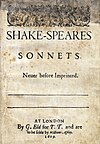Sonnet 27
Sonnet 27 is one of 154 sonnets written by the English playwright and poet William Shakespeare.
Structure
Sonnet 27 is an English or Shakespearean sonnet. The English sonnet typically consists of three quatrains followed by a couplet. This poem follows the usual rhyme scheme of its type, abab cdcd efef gg. Sonnet 27 is largely written in iambic pentameter, a type of poetic metre in which a line is constructed with five pairs of unstressed/stressed syllables. Lines eleven and twelve depart from this pattern, as both contain an eleventh syllable, known as a feminine ending.
| Stress | x | / | x | / | x | / | x | / | x | / |
|---|---|---|---|---|---|---|---|---|---|---|
| Syllable | Lo, | thus, | by | day | my | limbs, | by | night | my | mind, |
Analysis
Sonnet 27 is part of the Fair Youth sequence, in which the poet expresses his love towards another Man. Sonnet 27, when written using modern spelling, is Shakespeare's only pangrammic sonnet. It forms a diptych with Sonnet 28 which continues it.
For another of Shakespeare's sonnets dealing with night, sleep and dreams see Sonnet 43.
References
- Alden, Raymond (1916). The Sonnets of Shakespeare, with Variorum Reading and Commentary. Houghton-Mifflin, Boston.
- Baldwin, T. W. (1950). On the Literary Genetics of Shakspeare's Sonnets. University of Illinois Press, Urbana.
- Booth, Stephen (1977). Shakespeare's Sonnets. Yale University Press, New Haven.
- Dowden, Edward (1881). Shakespeare's Sonnets. London.
- Evans, G. Blakemore, Anthony Hecht, (1996). Shakespeare's Sonnets. Cambridge University Press, Cambridge.
- Hubler, Edwin (1952). The Sense of Shakespeare's Sonnets. Princeton University Press, Princeton.
- Kerrigan, John (1987). Shakespeare's Sonnets. Penguin, New York.
- Schoenfeldt, Michael (2007). The Sonnets: The Cambridge Companion to Shakespeare’s Poetry. Patrick Cheney, Cambridge University Press, Cambridge.
- Tyler, Thomas (1989). Shakespeare’s Sonnets. London D. Nutt.
- Vendler, Helen (1997). The Art of Shakespeare's Sonnets. Cambridge: Harvard University Press.
External links
 Works related to Sonnet 27 (Shakespeare) at Wikisource
Works related to Sonnet 27 (Shakespeare) at Wikisource- Paraphrase and analysis (Shakespeare-online)
- Analysis



